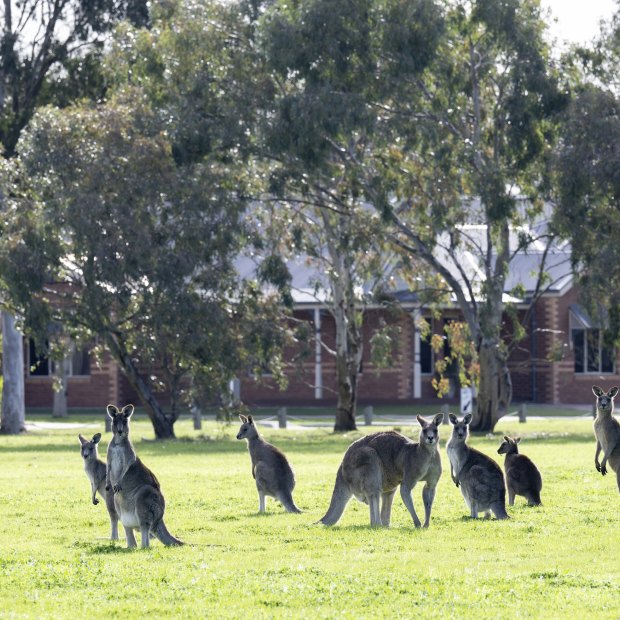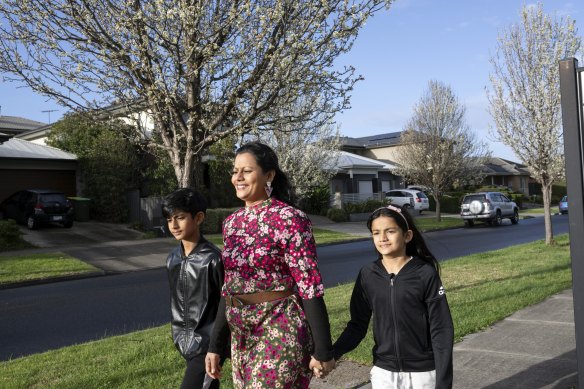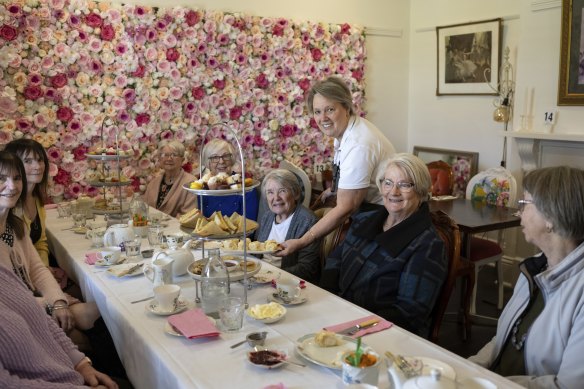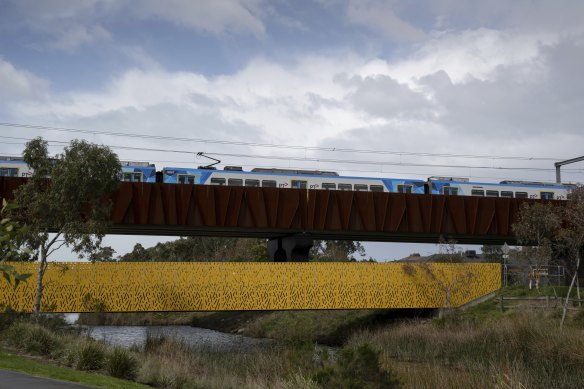
Kangaroos and housing in Mernda.Credit: PENNY STEPHENS
The train from Melbourne’s CBD to Mernda takes an hour, trundling past the tightly packed terraced houses of Abbotsford and Clifton Hill until, to the north, they give way to the squat brick-veneer homes in Reservoir.
“Look at that wind,” a teenage boy – lugging a skateboard and decked out in low slung jeans – says to his friend as they stare out the carriage window. “It’s actually scary.”

Shweta Bhatti, the president of the Mernda and District Residents Association with her children, Om, 11, and Shreya, 9.Credit: Penny Stephens
The landscape gradually becomes more industrial, warehouses and commercial buildings, alongside swaths of green space like the Morang wetlands.
When the train draws to a stop in Mernda, the carriages are mainly empty. Only a handful of people get off.
We are at the end of the train line, where shiny newly built homes back onto green paddocks with grazing cows.
Mernda marks Melbourne’s fringe, where the city gives way to farmland – and it’s growing fast. The population has increased more 30 per cent, from 16,458 to 23,369, over the past four years.
The Age once asked author Helen Garner to spend a week taking day-trips by train out of Melbourne.
“I wrote about what entertained me or made me laugh” she writes in True Stories. “Mostly people talking, and landscapes.”
That was 1982, but in 2024 on the Mernda line, hardly anyone talks. Instead, they are glued to their devices.
Only the two teenage skaters converse, laughing as they watch videos on their phones and share a bag of chips from KFC.
Stephanie Montalti rarely catches the train. She lives and works in Mernda. No need to go into the city much.
She moved to the suburb 12 years ago, attracted by the good schools and open space for her children.
“We’re close to a lot of things, although we are in Mernda,” she says. “A lot of people think that you have to travel and there’s nothing out here, but there is so much going on.”
Montalti has witnessed dramatic change in the time she’s lived there.
“It was pretty much just all open space and farmland,” she says. “Not as many estates had opened up or shopping centres, there wasn’t a Coles or Woolies or anything like that, or high schools.”
Montalti runs Turners Bakehouse, which operates out of one of the area’s oldest buildings, constructed in 1870 by Scottish immigrant Moses Thomas.
“He built quite a few properties in Mernda,” she says. “I guess you could call him the Metricon of his time.”
The old bakery’s wares were delivered – by horse and cart – as far afield as Heidelberg, cooked in a five-metre-long wood-fired Scotch oven that was imported from the United Kingdom in the 1800s.
The oven is still in working condition, but Montalti says it takes “a lot of wood and man power”, so they no longer use it to bake the bakery’s house-made bread and pastries.
She does have plans for wood-fired pizza nights.
Local historian Neil Johnson is Thomas’ great-great-grandson. He describes his ancestor as the “father of Mernda”, building the bakehouse, the Bridge Inn Hotel, a church, a school, a bridge over the Plenty River and a flour mill.
“Everything he built is still standing,” Johnson says.
Before white settlement, Mernda’s grasslands dotted with river gums were home for the Wurundjeri woi-wurrung people, with archeological excavations at Thomas’ original hotel – the Old Bridge Inn – in 2015 uncovering prehistoric stone tools.
The name Mernda itself is derived from an Aboriginal word thought to mean “earth”.
Thomas bought 400 acres of land off the Crown in Mernda. There was no acknowledgment in that time of the Indigenous owners of the land who were dispossessed.
Thomas’ first pub on the banks of the Plenty River was made out of wattle and daub, but in 1855 he shifted it to its existing location on Plenty Road to make the most of the passing trade to the goldfields. In 1891, the wooden structure was replaced by the brick building that still stands.
“He was a canny Scotsman and he knew how to make a dollar,” Johnson says over a drink at the Bridge Inn Hotel, which only retains the original facade and is now a sprawling complex with a TAB and bistro.
Johnson says the pub, in its early days, was a resting spot for bushrangers, a room for council meetings – and the basement housed the local morgue.
“At a glance, Mernda looks to be a new suburb,” Johnson says. “But if you scratch the surface, it’s the exact opposite, it’s an old suburb, its history is deeply rooted back to the very first days of Melbourne.”
Another local landmark is Carome Homestead, which was built in 1864 from local bluestone and is managed by Working Heritage.
Kerryn Cutting operates the Two Beans cafe at the homestead, serving breakfast, lunch and high tea.
“It’s a beautiful old homestead and a lot of people don’t even know it’s here,” she says. “There’s a swimming hole down the back where the kids all swim in summer and people take their Eskies.”

Kerryn Cutting serves customers high tea at the Two Beans cafe which she operates out of the historic Carome Homestead in Mernda. Credit: Penny Stephens
Kangaroos hop across the lawn at Carome Homestead, but the rural tranquillity quickly gives way to a sprawling housing estate right at the front fence.
These new estates house young families and new immigrants – 51 per cent of Mernda’s population has both parents born overseas.
The suburb is home to a large South Asian population, with 11.4 per cent of residents reporting Indian ancestry. A further 10 per cent have Italian heritage and 5.7 per cent Irish.

The swimming hole at the back of Carome Homestead in Mernda. Credit: Penny Stephens
Shweta Bhatti moved to Mernda from Sydney six years ago.
When asked about the area’s transformation in that time, she says: “Oh. My. God!”
“When we moved, it was very beautiful. Some of the hills were empty, and it was a very nice view,” she says.
“Now most of the hills, they have cut up and constructed buildings around the area. I used to go to a small hilltop view place to go and see the sunset sometimes, and now it is overlooking a concrete area instead of nice area of landscaping.”
Bhatti has a young family and is president of the Mernda and District Residents Association.
She says while she loves the area, she wants more facilities for children.
“We don’t have much sports areas or picnics,” she says. “The council keeps on promising a swimming pool and indoor sports ground for kids, but we don’t know when it is going to happen.”
It’s long been on the drawing board, with a $180 million facility approved in 2022 by Whittlesea council including six indoor sports courts, eight outdoor netball courts and a 50-metre pool.
But construction of the pool is yet to begin.
A spokeswoman for the council said more funding was needed from state and federal governments to build the pool. “The provision of stage three of the project – the aquatic and leisure facilities will be considered by council in the 2025-26 financial year.”
The local federal MP, Labor’s Rob Mitchell, says the council had “punched on” for years over whether the planned pool should be 25 metres or 50 metres.
“Pools are not cheap, they are expensive to run,” he says. “The state government has been good at building schools and that sort of stuff, social infrastructure has been more challenging just getting the room to build things.”
“The previous council did not cover itself in glory, there was so much ratepayer money wasted in internal bickering,” he says.
“The state government was right to bring in administrators. Personally, I’d like to see another four years.”
In October, new councillors will be elected – but monitors will remain in place for a year to “guide” them.
“The challenges is when you deal with growth it always keeps you on your toes,” Mitchell says. “The rail has made a huge difference.”

The railway line was extended to Mernda following a community campaign. Credit: Penny Stephens
Mernda was without a train line for 59 years but a $600 million extension was added from South Morang in 2018 – forming the Mernda line.
Darren Peters headed up the South Morang and Mernda Rail Alliance, which ran a 10-year community campaign to get the line.
He says he was inspired to act after the state government promised the railway extension in 2003, then reneged.
“I could see if it wasn’t built it would cause major problems,” he says.
Peters says Mernda is part of Melbourne “like any other suburb”, and has all the major chains and a variety of housing options, but lacks a lot of infrastructure.
“If the government is allowing 60,000 residents to move into an area without duplicating roads or providing essential infrastructure everything is going to collapse because people can’t enter or exit the suburb,” he says.
Alighting at Mernda, the new “Mernda Town Centre” – a small indoor shopping centre dominated by a Woolworths – is difficult to access from the railway station, facing instead out to the carpark.
Patrick Fensham, president of the Victorian branch of the Planning Institute of Australia, says having a major public transport connection is a minimum requirement for a high-growth suburb.
“The issue that we’re finding, and even with a place like Mernda, is that the distance you need to travel, even though you have got a public transport connection, to access major employment markets remains problematic,” he says. “It’s always a problem with growing suburbs.”
Fensham says while outer suburbs such as Mernda are sometimes derisively referred to as “dormitory suburbs” – where people sleep rather than work and socialise – that is hopefully a transient phase.
“It’s inevitable that we have these lags and delays in terms of lifestyle and amenities catching up,” he says.
Mitchell says more doctors are also needed in the area, but it is promising to see the Whittlesea Community Hospital under construction in Mernda and set to open in 2025.
Fensham says the focus in high-growth suburbs needs to be on investments to grow and expand the local economy to create more local jobs and access to transport.
“We need to think about [train] frequencies, but also we need to think about the network of supporting transport which provides access to that public transport node and that’s a good bus network,” he says.

Sienna Meublok and Tori Voss waiting for the bus at Mernda Station. Credit: Penny Stephens
At the station, friends Tori Voss and Sienna Meulblok are chatting while they wait for a bus.
“It takes a long time to get anywhere,” Voss says. “On Sundays it is every 40 minutes there is a train, so if there is one that gets cancelled – good luck to me getting to work.”
Voss says she was at studying at La Trobe in Bundoora – the closest university to Mernda – and it took an hour-and-a-half on public transport to get there.
“You definitely need more buses that go to different places,” Meulblok says. “I work in Doreen, which is just the next suburb over, and I have to take almost three buses to get a 10-minute journey.”
Neither Voss or Meulblok drive and so can feel isolated in a suburb that is so car dependant beyond the train station.
“It feels like it’s away from everything here,” Meulblok says. “There’s not much shopping or things to do besides looking at nature. That’s nice, but there is a limit.”
The Morning Edition newsletter is our guide to the day’s most important and interesting stories, analysis and insights. Sign up here.